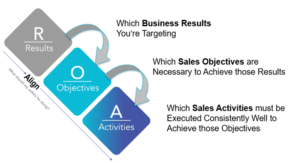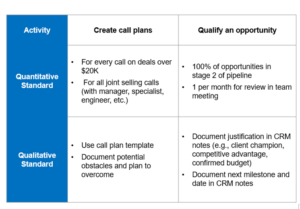The Importance of Simplicity: How Top-Performing Sales Manager’s Laser Focus Drives Results
All sales managers want to get it right. Just tell me the right way to manage and coach my salespeople and I’ll do it. Oh, how provocative is the fallacy of the one perfect approach. We want the magic pill, the final answer, the definitive solution. Everyone wants the secret sauce. Alas, it doesn’t exist. That’s the bad news. The good news is that top-performing sales managers aren’t magical or mystical. They are focused in ways their lower-performing peers are not.
What do focus and simplicity have in common? The best sales managers know they can’t do everything. In fact, time can be a sales manager’s biggest enemy if not harnessed effectively. Recent studies indicate that the average sales manager only spends about 32% of their time managing their team. This sad, but true finding is not the end of the world. How that 32% of time is used makes all the difference.
The Three Most Important Questions
In our research published in our books Cracking the Sales Management Code and Crushing Quota, we indicated that sales managers cannot manage outcomes, only the activities that lead to those outcomes. But which activities should they manage? How is managing activities different from measuring activities? How do they work together? And what does this have to do with coaching? Top-performing sales managers use a very specific framework for focusing their efforts. They examine their teams and answer three critical questions to isolate the highest impact efforts. The three most important questions a sales manager can ask and answer are:
- What should my salespeople be doing? Which activities are most critical to achieving the KPIs and outcomes needed to achieve and exceed quota?
- What should I as their sales manager be doing to best enable and equip my salespeople to succeed?
- How do I know if it is working? What are the indicators of success I can use to ensure progress is being made?
What Should My Salespeople Be Doing?
This vital question is the foundation for laser-focused sales management. Top-performing managers are diligent about tying the activities they expect their salespeople to execute to the sales objectives / KPIs that matter. Those sales objectives / KPIs are meaningfully connected to the business results the sellers are held accountable to achieve.

Once these “high-impact” activities are identified, top-performing sales managers ensure that they create clarity of task for their salespeople. They do this by ensuring that standards are put in place to remove ambiguity for their sellers. The most typical standards involve quantitative expectations for activity execution. Make 10 sales calls per day. Deliver 20 proposals per quarter, etc. This is the easiest part of activity management; it is just not the most important part. The critical standards high-performing managers provide are qualitative. They clarify what “good” looks like. They over communicate the vital elements of effective execution for the activities that matter most, leaving nothing to chance.

This diligence in isolating the highest impact activities and the associated standards answers the first question: what should my sellers be doing? This is the foundation of effective sales management. Without this laser focus, manager efforts are likely to miss the mark. With this foundation in place, sales managers are then ready to tackle the next question: how can I enable my sellers to succeed? What is my role?
How Can I Enable My Salespeople?
Creating clarity of task for the salespeople is critical, but only the first step. Top-performing sales managers apply the same laser focus to their own efforts, ensuring that the effort applied will lead to results. Of all the things a sales manager could coach, which ones should they coach? Well, the ones that matter most. The high-impact activities. Even though salespeople execute a wide range of sales activities, managers can’t and shouldn’t attempt to coach all of them.
Top-performing sales managers orient their precious coaching time to coaching the highest impact activities consistently well. They make time for what matters most and pay far less attention to what matters less. In fact, our research indicates that many ingrained beliefs about effective sales coaching are just plain wrong. Intuitively appealing, and wrong!
Top-Performing Sales Managers Don’t Do the Following:
- Coach each of their salespeople more frequently
- Spend more time in the field
What? That can’t be true! Well, it is. Get over it. Now let’s explain what they do and why they do it. The highest performing sales managers coach each of their salespeople less frequently, but for longer durations. They determine the best rhythm of coaching for the activities that are most important. Once the highest impact activities are identified, top-performing sales managers determine how frequently each salesperson should be coached and the most effective content of those coaching conversations. They schedule these coaching conversations to highlight their importance and keep to the schedule they’ve put in place. They do this with the minimal effective dose of coaching. Why? Because they know that conditions for coaching are never optimal, so they plan for the worst, not the best.
So, if once per month is sufficient, they don’t coach an activity every two weeks. Over time they determine what amount of coaching is enough to get the job done. This is why simplicity matters. This goes against conventional thinking for over achievers who want to set “stretch” goals. They simply don’t work in this situation. More is not always better, certainly as it pertains to effective and realistic sales coaching. Identifying the most important sales activities to coach and coaching them consistently ensures that coaching effort is applied in the right amount and in the right way. The next thing top-performer sales managers do is determine which needles need to move and by how much to achieve the team’s goals.
How Do I Know if it is Working?
This last critical question forms the final element of an effective sales management framework. It replicates how top-performing managers simplify their coaching task and get more of their salespeople to quota. Thirty five percent more as compared to their lower-performing peers. When they’ve done the heavy lifting of making direct connections between business results – sales objectives/KPIs – and high-impact activities, the path to progress becomes clear. These managers don’t wait until sellers are far behind quota to take action. They monitor the sales objectives/ KPIs on a regular basis to ensure that progress is being made, and they take needed action when it isn’t.
They look at things like win rates, time in each deal stage, level of opportunity qualification. They look at the contents and progress of their seller’s pipelines, and coach accordingly. This is how top-performing sales managers use data. If the right activities are being executed in the right way, the right needles should be moving. Period. If they’re not, adjustments are made.
To learn more about coaching practices of high-performing managers, check out our most recent book Crushing Quota: Proven Sales Coaching Practices for Breakthrough Performance on Amazon.
VantagePoint Performance is now part of Imparta, a global leader in performance improvement for customer-facing teams.